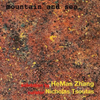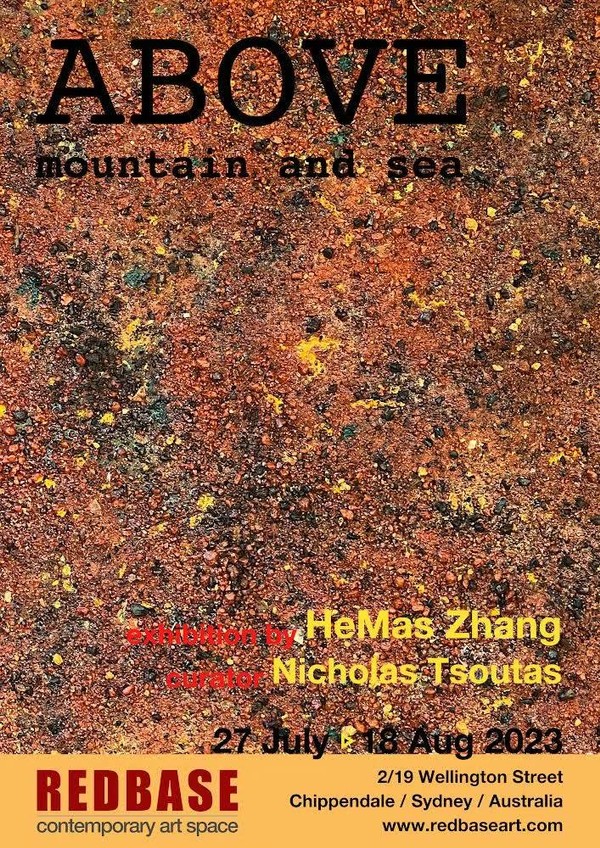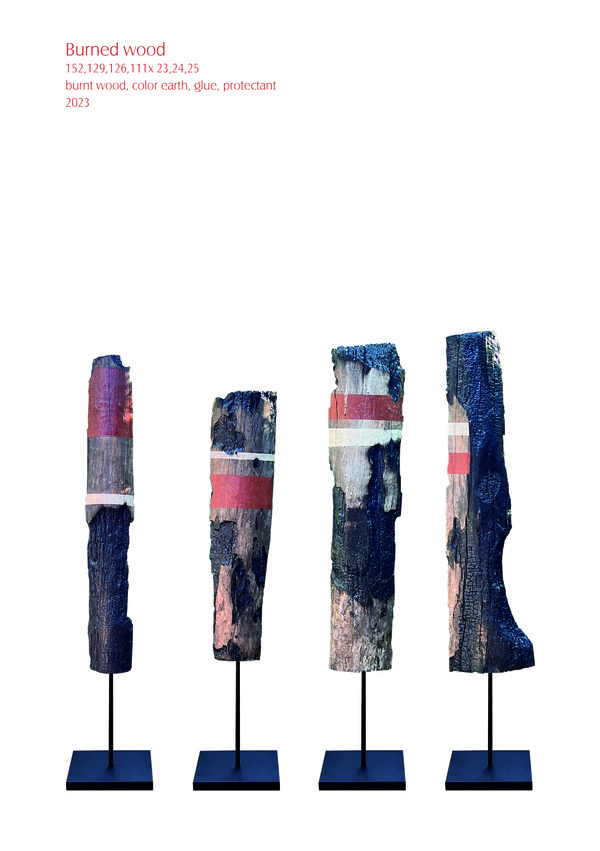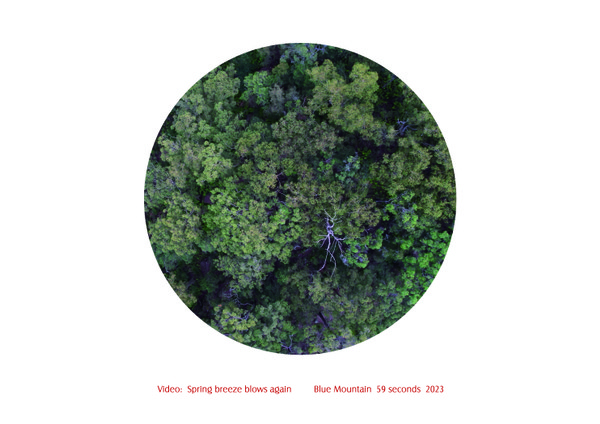分享到微信,
请点击右上角。
再选择[发送朋友]
或[分享到朋友圈]

2023-07-25 12:03
张华洁:至上山海
HeMas Zhang:ABOVE Mountain and Sea
2023.7.27 - 8.18
策展人:尼古拉斯·楚塔斯
Curator: Nicholas Tsoutas
红空间当代艺术中心•悉尼
Redbase Art Space•Sydney

旅澳三年的张华洁最新个人展,在澳大利亚悉尼红空间(Redbase)举行。
这是创作力旺盛的当代艺术家张华洁和澳洲著名策展人、艺评家尼古拉斯•楚塔斯(Nicholas Tsoutas)以及当代艺术红空间(Redbase)的首次合作,将呈现融多媒体、绘画、装置于一体的综合视觉艺术展。展出有丰富肌理层次和神秘沉浸式的展场氛围。
尼古拉斯·楚塔斯(Nicholas Tsoutas)为此撰文评论了张华洁的澳洲新作:
生命之迹象
《至上山海》(ABOVE Mountain and Sea)是当代艺术家、电影制作人张华洁(HeMas Zhang)的最新艺术个展,是他对澳洲风景的冥想和精神交流的产物。在蓝山隐居地Sinofield住留期间,张华洁通过对时间流逝的体验来探索人与自然的关系,既直接感受并观察蓝山深邃古老的景观,也以与佛僧对话的角度来体验独特的环境。从不同的文化视角出发,张华洁为观众提供了一种对这片古老土地不同寻常的理解。因为他的抽象艺术上升到了有形的土地之上,而有形的土地是得以让他轻轻触摸且近乎精神联系的媒介。本次艺术展提请观众审视自己 与这个环境的关系,当我们与这个地方、这片大陆和这段历史联系在一起时,反思我们实际看到的是什么?我们怎么看?怎样去看到?
张华洁认为先秦时期的古籍《山海经》对他的创作有一定影响。《山海经》问世于公元前 4 世纪,它记录了远古神话和地理探勘,系统地记录了数千年前的气候变化、迁徙和生态环境,包括山地、水道、矿产、动植物分布等;这部兼收并蓄的古籍还记录了人类活动的信息,包含了对祭祀仪式的描述以及重大灾难事件的预兆,人与自然的和谐共生。《山海经》犹如一场经典而壮观的导览,从已知的古代世界,从中国中部的著名山脉向外延伸到海外之地。受其影响,张华洁在创作中表现出了对外部世界的自觉意识;对一个超越已知的空间、一个存在于知识、地理边界、甚至意识之外的未知世界的自觉意识。这种自觉意识非常重要,因为就精神和物质层面而言,它对未知事物的探索超越了已知世界的限制,它寻求扩展和超越已知理解范围的可能性。对于有好奇心的人来说,已知的事物本身总有不足或不够完整。
与《山海经》中的神话旅行者不同,张华洁的创作之旅是一种当代启蒙之旅,也是一种对新观念和新的无限可能性“发现”的惊叹;他所目睹和感知的一切超出了已知的范围,这大大扩展了艺术家的视野。创作于他是一个新的启示,张华洁从蓝山这个离天堂更近的精神之地出发,以隐居者的角度观察广袤辽阔的澳洲大地,那个可能是《山海经》中提到的海外之地。这种视角的改变,使他能够超越之前认知的局限性来重新想象地球。对于张华洁来说,这就像他自己和他的存在的更新,不仅意味着他渴望在与世界关系的理解中、在精神成长上得到滋养,而且代表着如何批判性地在精神层面上表现世界。张华洁的惊奇不仅仅在于看到一座新的山或见证新的事物,而且他理解新事物的体验对他隐含的意义。无论在物质还是精神层面上,他对这些扩展的知识的理解,让他发挥出创造力并在美学上利用其潜力。正是在这里,《山海经》穿越了时间、穿越了历史,因为,它赋予了我们如何想象超越已知边界的世界的意义,我们与未知的相遇,通过我们现在所知道的可能性,让我们重新遇到我们曾经知道的东西。这是一个对未知的渴望的故事,在这种情况下,既是超越也可能是至上,在物质现实与天堂之间的至上,是对存在的想象或形而上的超越。

对张华洁来说,他的艺术就像《山海经》一样,是一种穿越历史的知识,是对生命迹象的敏感;他关注人性、关注历史与人类命运的对话和救赎。张华洁在对地形的思考中,近乎哲学地创造了一种对环境干扰最小的艺术,他利用泥土、灰烬和小砾石等材料,创作出他对土地的体验、近乎单色的抽象绘画。张华洁回收了蓝山丛林大火中烧焦的树干,将它们重新制作成雕塑,这些雕塑似乎既是对时间的证明,也是拒绝屈服于丛林大火毁灭性破坏的象征。他用无人机拍摄的视频,镜头绕着树林之尖顶慢慢盘旋,深情表达了这片土地的美丽,及其在时间流逝中的存活。张华洁将这段视频投影在盐床上,意在表现数百万年前存在于海平面以下的蓝山的深厚历史。他对蓝山这个地方有深切的热爱和关心,他把地域的空间与时间协同起来,以一种深刻的整体性和相互依存的神性将山与海连接起来,这让他能够冥想并创造出独特的雕塑装置,来表达对这片古老土地的尊重。作为一个旅澳华人艺术家,张华洁与澳洲风景的相遇,每时每刻都有遇到新的可能性,他尊重差异,心怀敬畏,重新审视自己与生存环境的关系。
艺术家对澳洲这片土地的好奇心,驱使他在承认文化差异的同时,也密切关注所到之处物质显现出来的差异特性。张华洁对这片土地进行了更为仔细的审视,通过对时间对地点的冥想以及与历史的对话,通过直接让在场的物质作为媒介,他在创作中相应的表现手法不是具象的,而是抽象的、还原性的、极简主义的方法。他的“物质绘画”拒绝回应再现叙事的艺术,并在风格上与抽象表现主义的手法迥异;他在极简主义和几乎单色的沉浸中,选择了一种更具思辨性和观念性的态度。这种极简主义的方法从对自然和土地的景观表现转向更为详尽的聚焦,几乎是在微观上与那个地方的接触,这表明了一种不同的艺术思考方式,以及不同的参与背景。可见张华洁并不满足于简单地再现表象的真实,或是绘画中的表象幻象,而是更喜欢思考对真实意义的探索。张华洁的绘画瓦解了他对风景理解中的所有空间视角,他采用了强烈的色彩饱和度作为一种形式,批判性地在美学上打破了山水风景的惯例。他创作的这些画是分层的,或以某种触感质地为基础,由烧焦的余烬和微小的泥土或砾石颗粒组成,所有这些都指向蓝山这个地方,为观众提供了对地方本身以及生活的身灵感官体验。张华洁深情注视这片土地,几乎是在与地方、自然和环境的冥想邂逅中,与这个地方的历史相遇。这个地方的材料对于他的作品创作至关重要,大地的赭色对他来说也很重要,就像颗粒状的砾石和黑炭灰一样,因为正是这片土地赋予了他创作灵感,并通过画作使它们得以呈现。

张华洁的树干雕塑装置是立体的直立的,几乎是拟人化的,就像正在进行表演仪式的人物,庆祝自己的存在和存活。丛林大火代表着灾难性事件,烧焦的树干不仅是那个地方被火灾蹂躏的证据,更重要的是火灾后的新生、重建的可能性以及自然的恢复力。更新是这些雕塑的中心主题,因为艺术家关注环境破坏以及气候危机对地球上所有生物、人类、动物和植物的影响。这些雕塑还描绘了一个没有人类的世界,作为对人类价值观的隐喻。对于张华洁来说,他与自然的关系是有先见之明的,他的雕塑充满了人的形态,被赋予了一种尊严,暗示着人类与自然之间相互依存的关系。尽管这些树干遭受了山火烧灼,他还是给予这些雕塑应有的尊重,因为正是这些曾经生长在自然环境中的树木,让人类能够呼吸生存所需的氧气。耐人寻味的是,被烧残的树干雕塑围成一圈,被一片绿色茂盛森林的航拍视频所围绕,也许暗示着森林正在萎缩,也许表现森林正在更新、并在再生过程中呈现生命迹象。鉴于当今全球范围内的天然森林环境因为商业利润而遭到破坏,张华洁的这部作品具有警醒世人的社会政治意义。
在某种程度上,张华洁用他的艺术作为与观众对话的一种方式,与他们交流他对人类生存的脆弱和不稳定状况的担忧;并提醒观众,人类的行为会对地球的未来产生隐患和危险后果。他利用艺术之美来切入由自然灾难引发的社会变革问题,迫在眉睫需要解决的问题。因为他敏锐地意识到一些策略不能是中立的,他理解艺术家的职责超越了美学和艺术美的功能。重要的是他如何传达这些问题,如果他能成功传达自己对一个地方的担忧,就像和其他人平等分享他对一个地方的享受一样,那么,他的作品就反映了那个地方的深厚历史和相关环境,艺术就可以发挥社会责任。张华洁通过这种方式,用艺术分享自己的意识,同时激发他人的意识,当人们审视自身存在的理由并反思人性时,相信艺术有这种张力表达对更大远景的关注。张华洁本次的多媒体综合艺术展是对生活充满乐观主义的静思冥想,他用艺术创造了一个空间,让人思考与环境和地球更可持续的关系,尤其是在这些环境脆弱受到挑战的时代。
(翻译:海曙红)
Signs of life
Curator
Nicholas Tsoutas
ABOVE mountain and sea, by interdisciplinary artist, film maker, HeMas Zhang, is a meditative and spiritual engagement with the Australian landscape. HeMas Zhang explores the relationship between human beings and nature through the experience of the passage of time. This exhibition was developed during his residency at Sinofeild, a Blue Mountains retreat, enabled him to directly feel and observe the profoundly ancient landscapes of the Blue Mountains whilst experiencing the unique environment through the lens of conversations with Buddhist monks. His different cultural perspective, provides us with a different understanding of the awareness of the old history of this land, as his abstraction rises above the land with a topographical almost spiritual connection that allows him to touch this land lightly. In doing so he asks us to examine our relationship with this environment and reflect upon what is it that we actually see? And how we see? And how we look? when we connect with this place , with this continent and with this history.
Zhang acknowledges his influence by the Classics of Mountains and Seas, also known as Shan Hai Jing, a Chinese classical text from approximately 4th century BCE, which systematically and comprehensively records mythical geographical overviews of the Qin dynasty, whist providing future generations with information of the ecological environments, including mountains waterways, mineral, animal and plant distribution, recording climate changes, migration and information of ecological environments and human activities thousands of years ago. This eclectic work also contains crucial accounts of rites of sacrifice along with omens of overt catastrophic events, in a classically spectacular guided tour of the known worlds of antiquity, whilst moving outwards from the famous mountains of central China to the lands beyond the seas. The writers display a conscious awareness of an outside, a space beyond the known, an unknown world that exists outside the borders of knowledge, of geography, and indeed the borders of consciousness itself. This awareness, is significant insofar that it is crucial for exploring the unknown beyond the limits of the known world, both spiritually and physically in a quest to exceed and expand on what is possible beyond the comprehension of knowing. To the curious mind, the known will always be insufficient and incomplete in it and of itself.
Not unlike the mythical traveller in Shan Hai Jing, HeMas Zhang’s journey is one of contemporary enlightenment, and one of the awe of wonderment with the “discovery” of new and perspectives and new endless possibilities, that expand his own horizon, whilst what he witnesses exceeds what is already known. This is a new revelation for him, and from the perspective of the retreat in the Blue Mountains, a spiritual place closer to heaven, he observes the vastness Australia, that place beyond the seas possibly referred to in Shan Hai Jing. This change of perspective allows him to reimagine the earth beyond his previous limits and the limitations of knowledge. For Zhang, this is like a renewal of himself and his being and represents a spiritual growth not only of knowledge that he desires to nourish his understanding of himself in relation to the world, but also how to represent the world, critically and spiritually. His wonderment is not just in seeing or witnessing something new, or something as literal as a new mountain for the first time, but it is his understanding what the experience of the new means implicitly to him, and how he make sense of this expanded knowledge both physically and spiritually as well as how he can creatively and aesthetically harness its potential. For Zhang, it is here that the Classic of Mountains and Seas functions through time and travels through history as it gives significance to how we now only imagine the world beyond the existing borders of what is already known, but our encounter with the unknown allows us to re-encounter what we once knew through the possibilities of what we now know. This is a story of desire for the unknown, and in this case the beyond, which also suggests the above, the above between our physical reality and heaven. The above is also a reference to transcendence into the imagined or the metaphysical reality of being.
For Zhang, his art, like the Classic of Mountains and Seas, is about a knowledge that travels through history, that is sensitive to the traces of life, and pays close attention to the consequences of humanity and the dialogues of history and human destiny and salvation. In his topographical reflections, Zhang almost philosophically creates an art that almost minimally interferes with the environment by utilizing materials such as earth, ash embers and tiny pebbles, to create his almost monochrome abstract paintings of his experience with the land. HeMas Zhang also recycles burnt tree limbs from the Blue Mountain bushfires, recreating them as sculptures that seemingly stand as both a testament to time and a refusal to succumb to the destructive intensity of the bushfire heat. His drone video slowly circling a forest of trees is a profound statement of the beauty of this land and its survival through the passage of time. Projecting the video on a bed of salt acknowledges the deep history of the Blue Mountains which millions of years ago existed below sea level. This, in itself for Zhang is the perfect synergy of time, in a sense of regional locality, that connects mountains to the sea in a profoundly holistic and interdependent Buddhist relationship that suggests for him a deep love and care of this place, and allows him to create a meditative installation of quiet respect for this ancient land. HeMas Zhang encounters with the Australian landscape is not dissimilar insofar as a migrant he encounters every moment with new possibilities with difference and with a sense of awe that re-examines his own relationship with place and environment.
For HeMas Zhang, is stimulated by his own curiosity of place, and in acknowledging its difference he pays close attention to the details of place, to its material particularities that signify its difference. The abstraction that he responds with is reductive as he focuses on, a minimalistic approach that is not representational, but instead a meditation of place through time and as a conversation with its history. He explores a strategy that encourages a close examination of place, a closer scrutiny with and of this land, by engaging it directly through the materiality of place. His “material paintings” reject an art that responds to the narratives of representation, and resists a stylistic conformity to the gestural approaches of abstract expressionist forms, but instead he chooses a more speculative and a more conceptual attitude in a minimalist, almost monochromatic rendering of place. This minimalistic approach shifts from the more landscape representation of nature and land to a more specific, more detailed focus, almost microscopic engagement with place that suggests a different way of thinking about art, along with a different context of engagement. HeMas Zhang is not satisfied with simply reproducing the reality of appearances, but prefers to meditate on his explorations on the meaning of the real rather than its representational illusion in painting. HeMas Zhang’s paintings collapses all spatial perspectives in his understanding of landscape, instead adopting a strategy of intense colour saturation as a form that critically and aesthetically undermines the conventions of landscape painting. The paintings however are layered or grounded with a certain textured tactility, of burnt embers and tiny grains of earth or pebbles, all specific to the geographic locality of the Blue Mountains, providing them with a sensory and bodily experience of place itself, and of lived encounters with the history of place. The materials are of vital importance to the production of his work as they suggest a direct symbiotic relationship to that place where he both encountered and collected them. Zhang is looking at this land deeply, almost spiritually in a meditative encounter with place, nature and environment. The ochre colour of the earth matters to him as does the granular pebbles and the black ash, for it is the very earth that informs his paintings and brings them into existence.
HeMas Zhang sculptures stand erect, almost anthropomorphically, like human figures engaged in a performative ritual celebrating their own existence and survival. The burnt trunks function as evidence, not only of the place ravaged by fire, where bushfire represents a catastrophic event but more significantly, of the possibility of renewal after the fire passes, and the resilience of nature. Renewal is a central thematic of these sculptures, as Zhang is concerned with the environmental destruction and the implications of the climate crisis upon all living things, humans, animals and all floral alike. The sculptures also depict a non-human world as metaphors for human values. For HeMas Zhang his relationship with nature is prescient, and his sculptures replete with human form, are given a dignity that implies an interdependent relationship between human beings and of nature itself. He provides these sculptures with a respect that they deserve despite their burnt suffering, acknowledging that these trees in the context of their natural environment allow us to breath the very oxygen that we need for our collective survival. Ironically the burnt tree trunk sculptures stand in a circle surrounding an aerial video image of a green flourishing forest, suggesting an ambiguity as to whether the forest is shrinking or whether the forest is again displaying signs of life in a process of renewal and regeneration. Given the global destruction of the natural forest environments for commercial profits, this work by Zhang has a chilling quality that is politically relevant today.
In a certain way, HeMas Zhang uses his art as a means of conversation with his audience to communicate with them his concerns regarding the tenuous and precarious condition of human existence, and to remind us of the dangerous consequences of our actions as they impact on the future of planet earth itself. He utilizes strategies of beauty and aesthetics engage the questions of social change that is needed so desperately to address the looming catastrophe, for he is acutely aware that such strategies are not neutral and understands that art must share a function beyond its own aesthetics and beauty. For him the serious question lies in how he communicates these issues, and if he can successfully communicate his own concerns through his enjoyment of place for others to equally share in his enjoyment of place, then his work can function with a social responsibility as reflections on the deep history of place and the significance of the environment in relation to place. In this way he can share his awareness through his art to provoke an awareness in others, with the belief that art has a capacity to register a concern for the bigger picture, and reflect upon our sense of humanity as we contemplate our reasons of existence. Zhang’s interdisciplinary exhibition works as a quiet meditation on the optimism of life, and creates a space that allows for the contemplation of a more sustainable relationship with the environment and the planet, particularly in these environmentally fragile and challenging times.

《至上山海》(ABOVE Mountain and Sea)将从七月二十七日展出到八月十八日。
红空间(Rebase)位于悉尼白兔美术馆旁,是一家重点推介东亚以及澳洲的亚裔当代艺术家的专业当代艺术空间。

分享到微信,
请点击右上角。
再选择[发送朋友]
或[分享到朋友圈]

